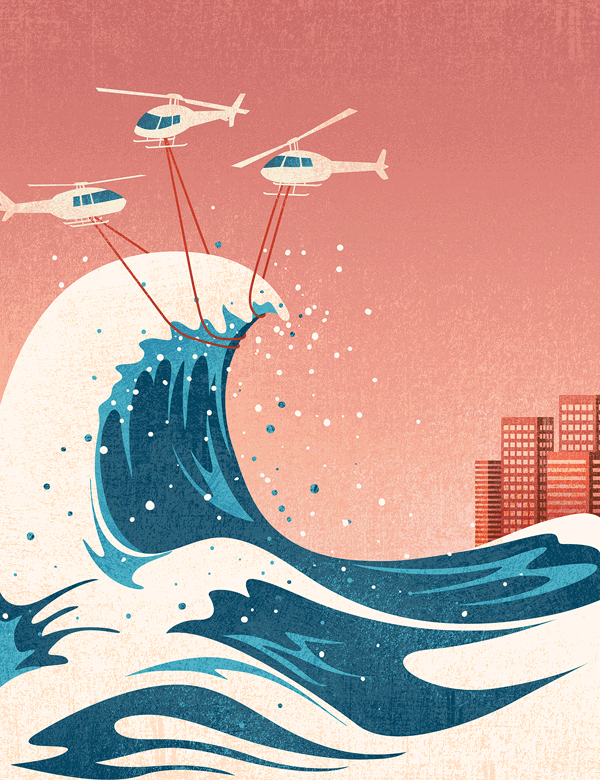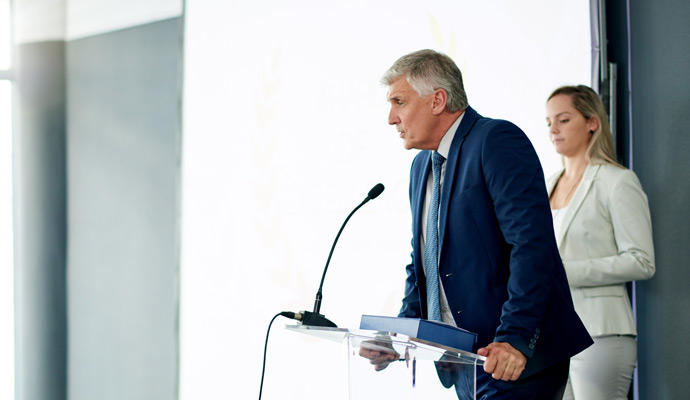Corporate first responders
Even in wealthy countries, companies can play a vital role in disaster relief.
A version of this article appeared in the Summer 2016 issue of strategy+business.
What happens when governments lack the resources to respond immediately to a natural disaster? When Japan was struck by a 9.0 magnitude earthquake and 100-foot tsunami in 2011, it was the world’s third-richest economy. But at the time, the country’s public debt stood at more than twice the level of its GDP, and its real interest rates were negative. Japan’s leaders found themselves with little in their economic arsenal to quickly draw down for emergency assistance. In the months after the disaster, national production faltered, Japan’s supply of goods contracted by an estimated 20 percent, and the country’s stock market and credit rating plummeted.
We’ve seen similar scenarios in Italy, after the L’Aquila earthquake in 2009; in New Zealand, after the Christchurch earthquake in 2011; and in the U.S., after Superstorm Sandy in 2012. All three were developed nations that, most experts assumed, could self-finance their recovery. Yet each suffered deeply when disaster struck and outstripped its state capacities.
In a recent study of these and other low-probability, high-magnitude disasters — calamitous black swans — during the previous two decades, we found that business has increasingly filled the recovery gap. The data shows a convergence among three areas: unmet high social recovery costs in many developed countries after a disaster; companies’ strategic decisions regarding aid; and the effectiveness and speed of aid delivery. As such, companies have been able to serve as a critical and effective stopgap in the aftermath of black swans in nations where the suffering is real but the vulnerability is underestimated or even obscured.
The Fragility Factor
In five of the world’s largest natural disasters during the past five years, companies gave more aid than foreign governments, multilateral agencies, nongovernment organizations, and private individuals combined. Japan’s 2011 earthquake, for instance, attracted an outpouring of donations from corporations that accounted for 58 percent of total aid.
Corporate donations after Japan’s 2011 earthquake accounted for 58 percent of total aid.
Of course, taken at face value, this type of corporate giving poses a vexing problem. Companies are donating most frequently to wealthier nations — some 85 percent of corporate donations over the last 15 years have gone to higher-income economies. These are typically nations where companies have strong interests or operations, or where they have a large customer base. Recent studies in corporate philanthropy have shown that the share of a firm’s income from a given market is a good predictor of its willingness to foster social welfare in that market.
Yet we also know that close to 90 percent of the deaths associated with natural disasters in the last three decades have occurred in low-income countries. Put more graphically: Nepal lost one inhabitant for every 3,000 residents from its 7.8 magnitude earthquake in 2015, whereas Japan lost one for every 10,000 from its 2011 disaster. In contrast with the overwhelming business response to Japan’s seismic event, corporate disaster giving accounted for less than 5 percent of Nepal’s international assistance. This disparity naturally raises questions about whether corporate disaster relief is truly satisfying a global social need.
To answer these questions, we looked at how a country’s capacity to finance relief and recovery in the wake of a black swan is traditionally assessed. The method of determining international aid for disaster recovery mimics the way public policy for international aid typically functions. The decision-making process for identifying national financial vulnerability thus relies on criteria such as a country’s GDP per capita.
As a result, during the last 30 years, the bulk of multilateral disaster aid has gone to low-income countries, such as Haiti after its 2010 earthquake or Nepal after its 2015 earthquake. (We are categorizing countries using World Bank definitions; low-income nations have a GNI per capita of $1,045 or less.) Middle-income economies (those with a GNI per capita of between $1,046 and $12,736) such as Chile and Mexico received just 8 percent of multilateral public disaster relief, and high-income economies (those with a GNI per capita of $12,737 or more) such as Japan and the United States, less than 2 percent.
But the well-documented struggles of developed countries to finance fast and efficient recovery efforts have made clear that economic development is a poor indicator of social need; it fails to capture the complex aftermath of major disasters. Broadly, a state has three sources for funding disaster response: government assistance, private plans (such as insurance), and international aid (which includes aid from foreign governments, multilateral organizations and NGOs, and individuals). The first channel is made up of three main instruments that a government can use to secure liquid resources after sudden shocks: debt, deficit, and interest rates.
Economic development fails to capture the complex aftermath of major disasters.
Using the total value of government aid, private plans, and international aid at the time of a disaster, we calculated states’ financial capacity to respond. We then ranked the 3,115 major disasters that occurred worldwide between 2003 and 2013 according to the magnitude of the gap between this capacity and the cost of a disaster — what we have termed state fragility to black swans. The results defied commonly held assumptions: 87 percent of the 150 disasters with the largest gap occurred in medium- and high-income countries.
We next conducted a series of econometric evaluations using data on disaster giving and our ranking of state fragility. The data set consisted of the reported international contributions by firms, foundations, nonprofit organizations, foreign governments, and multilateral agencies to relief and recovery of all major natural disasters worldwide from 2003 to 2013.
Corporate aid is in fact going to countries that are most financially vulnerable after a black swan.
Our analysis revealed that corporate giving is more likely to be allocated to countries whose government is less able to supply essential goods following so-called fat-tail calamities. These states have high fragility, but in many cases don’t receive a large share of aid from traditional sources as a result of their relative affluence. That is, corporate dollars are in fact going to the countries that are most financially vulnerable in the wake of a black swan.
Fast and Effective
As part of our study, we also sought to determine the efficiency of companies’ aid efforts. In our econometric evaluation, we found evidence that when corporate giving makes up at least 5 percent of total international aid after a disaster — which implies that firms are taking an especially active interest in a country’s recovery — recipients receive 37 percent more aid during the first four post-disaster weeks than they do when corporate intervention is less than 5 percent of total aid. In other words, when corporate aid has arrived with substantial magnitude, the assistance has reached the ground faster.
When corporate aid arrives with significant magnitude, the assistance reaches the ground faster.
This is significant, because most experts on disaster management agree that the time that elapses between the occurrence of a shock and the provision of essential goods (water, food, medicine, and housing, as well as the rapid restoration of such staples of the economic infrastructure as communication and transportation) largely determines the degree of disruption. And studies on disaster risk management suggest that whether a natural shock morphs into a full-fledged catastrophe or not depends greatly on the promptness of the response. For example, consider the impact of Hurricane Katrina on New Orleans in 2005: The consequences of the hurricane’s physical destruction were made far worse by the government’s inability to quickly deliver relief to victims.
Another sign of the business community’s ability to meet local needs is the extent to which in-kind corporate disaster giving (for example, removing debris, delivering supplies, and rebuilding schools) affects recovery. The ratio of in-kind to monetary giving varies across industries and countries, but our analyses revealed that when at least 30 percent of post-disaster business assistance to a country comes in the form of in-kind giving, recipients receive disaster assistance 65 percent faster than in statistically similar countries with lower levels of corporate in-kind donations.
Finally, we found that corporate disaster giving does not crowd out or replace international public assistance. If a country that has experienced a disaster receives no international aid, it’s more likely that businesses will donate there. But if some amount (still insufficient for recovery) of international aid is sent, the likelihood of corporate giving grows higher. The latter complements the former, rather than creating a substitution effect.
Preparing for Disaster
Our findings should not be interpreted as an argument for giving to the rich at the expense of the poor. That’s especially true because the entire system is in trouble: The inflation-adjusted annual cost of natural disasters worldwide nearly quintupled between 1980 and 2012, from $54 billion to $250 billion. Public assistance now covers only a median 5 percent of the cost of natural disasters globally. The costs of calamities also can be expected to rise because more people are living in disaster-prone regions, such as the “ring of fire” around the Pacific Rim, with its earthquakes, tsunamis, and volcanoes. And many national governments now face rising public indebtedness, making recovery increasingly challenging.
There’s no one answer to the complex problem of responding to these crises and their growing costs. But it’s clear that business giving is moving in a positive direction: In 2000, less than 30 percent of the world’s largest multinationals engaged in some form of disaster giving, including cash, goods, services, and sometimes even direct engagement in relief support and logistics. By 2013, that figure had risen to more than 90 percent.
Most big companies are now giving, but all should consider giving more. Our findings suggest a new way of thinking about disaster relief that should inform corporate social responsibility leaders. Financing recovery efforts in states ill-prepared to respond has become a major challenge for the international community — and one that corporate aid can help overcome.
Reprint No. 16204
Author profiles:
- Luis Ballesteros is a doctoral candidate in management at the University of Pennsylvania’s Wharton School.
- Michael Useem is a professor of management and the director of the Leadership Center at the Wharton School.





